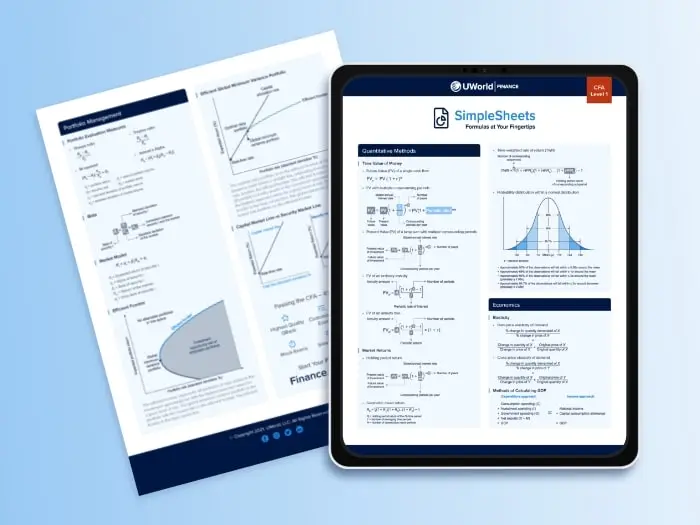Mastering the CFA® Level 2 Exam
Topics, Weights, and Insights
The CFA® Level 2 exam requires a deeper understanding of investment management and portfolio theory. You will be challenged with real-world scenarios that test your knowledge. It is crucial to thoroughly comprehend the topics covered in Level 2, as it is closer to the CFA charter.
CFA Level 2 Exam Topics
The CFA Level 2 exam tests your knowledge on 10 different topics, including:
| CFA Level 2 Topics Overview | |||
|---|---|---|---|
| Topics | Weight | No. of Learning Modules |
No. of Questions |
| Ethical and Professional Standards | 10-15% | 3 | 8-12 |
| Quantitative Methods | 5-10% | 7 | 4-8 |
| Economics | 5-10% | 3 | 4-8 |
| Financial Statement Analysis | 10-15% | 7 | 8-12 |
| Corporate Issuers | 5-10% | 4 | 4-8 |
| Fixed Income | 10-15% | 5 | 8-12 |
| Portfolio Management | 10-15% | 6 | 8-12 |
| Equity Valuation | 10-15% | 6 | 8-12 |
| Derivative Investments | 5-10% | 2 | 4-8 |
| Alternative Investments | 5-10% | 4 | 4-8 |
The topics covered in the CFA Level 2 exam are divided into 4 functional areas, also known as "study sessions":
- Ethical and Professional Standards
- Code of Ethics and Standards of Professional Conduct
- Guidance for Standards I–VII
- Application of the Code and Standards: Level II
- Quantitative Methods
- Basics of Multiple Regression and Underlying Assumptions
- Evaluating Regression Model Fit and Interpreting Model Results
- Model Misspecification
- Extensions of Multiple Regression
- Time-Series Analysis
- Machine Learning
- Big Data Projects
- Economics
- Currency Exchange Rates: Understanding Equilibrium Value
- Economic Growth
- Economics of Regulation
- Financial Statement Analysis
- Intercorporate Investments
- Employee Compensation: Post-Employment and Share-Based
- Multinational Operations
- Analysis of Financial Institutions
- Evaluating Quality of Financial Reports
- Integration of Financial Statement Analysis Techniques
- Financial Statement Modeling
The Level 2 exam consists of 22 item sets, comprised of vignettes with 88 accompanying multiple-choice questions, split between two 132-minute sessions (session times are approximate). There is an optional break between sessions.
- Morning Session (2 hours, 12 minutes): 44 multiple choice questions, covering the topics of ethics & professional standards, quantitative methods, economics, and financial statement analysis
- Afternoon Session (2 hours, 12 minutes): 44 multiple choice questions, covering the topics of corporate issuers, equity, fixed income, derivatives, alternative investments and portfolio management.
Source: CFAI

Overview of CFA Level 2 Exam Subjects
The CFA Level 2 exam curriculum has remained largely unchanged since 2021, similar to the Level 1 exam. The removal of Publicly Traded and Real Estate Securities and the addition of Backtesting and Simulation are among the minor changes. In addition, CFAI's Evolution 2024 update has introduced a Practice Skills Module (PSM) for Level 1 and Level 2 candidates. The PSM is a video-based training program that includes multiple-choice questions, guided practice, and case studies. The PSM topics can be selected at any time during the exam study period and typically take 10-15 hours to complete.
[3 Learning Modules | None]
In the Level 2 exam, Ethics is given a weight of 10-15%. The majority of the Ethics coursework in Level 2 is similar to what is covered in Level 1, with a few additional topics such as the soft dollar standard, the research standard, and investment guidelines. However, the questions in the Level 2 exam are more difficult because they are presented as item sets and involve different contexts.The questions are more challenging because they are presented in item sets with different contexts. Read more on this topic at the Ethical and Professional Standards page.
[7 Learning Modules | 50 formulas]
The weight of QM in the Level 2 exam is about 5-10%, whereas it is not a significant part of the Level 1 exam. This course focuses on analytical tools and discounted cash flow analysis, which form the basis for evaluating securities and assets. It also covers probability theory and its application to measure the risk involved in investment decision-making. For a much more detailed read, visit the Quantitative Methods page.
[3 Learning Modules | 50 formulas]
This particular section of the exam carries a weight of 10-15%. It aims to evaluate your understanding of the basic principles of supply and demand concerning individual consumers and firms. You will also be tested on your knowledge of different market structures that firms operate in, along with macroeconomic concepts and principles. Towards the end of the section, there will be a discussion about the business cycle and its impact on economic activity. If you perform well in Level 1, you should not have any difficulty in this section at Level 2. Our Economics page contains a thorough discussion of each reading included in the topic.
[7 Learning Modules | 40 formulas]
Financial Statement Analysis (FSA) comprises around 10-15% of the Level 2 exam. FSA involves the examination of primary financial statements, with a focus on basic financial statements, as well as the impact of alternative accounting methods on these statements and their analysis. Visit our page on Financial Statement Analysis for a much more in-depth understanding of the subject.

[4 Learning Modules | 40 formulas]
The topic you will be studying covers three main areas: corporate governance, investment and financing decisions, and stakeholder management. In order to excel in this area, you must have a strong understanding of how corporate governance works and how to manage stakeholders effectively. Additionally, corporate finance will make up 5-10% of the topic weight in the level 2 exam. For much more detailed information, visit the Corporate Issuers page.
[5 Learning Modules | 60 formulas]
This topic covers various aspects related to fixed income securities and their markets, including yield measures, risk factors, and valuation measurements and drivers. It also includes topics such as calculating yields and fixed-income securities' values, securitization of assets, fundamentals of bond returns and risks, and basic principles of credit analysis. In the Level 2 exam, Fixed Income accounts for 10-15% of the exam. For more insights into the topic, visit the Fixed Income page.
[6 Learning Modules | 70 formulas]
The topic's weightage for Level 2 is 10-15%, which marks a significant increase from its weightage at Level 1. This subject delves into the basics of portfolio and risk management, which includes measuring returns and risks, planning and constructing portfolios, addressing the needs of individual and institutional investors, and examining the different investment options available. Detailed information is available on the Portfolio Management page.
[6 Learning Modules | 100 formulas]
Equity Investments is a topic area that covers various aspects of equity investments, including the features of equity investments, security markets, and indexes. It also involves analyzing industries, companies, and equity securities and utilizing basic equity valuation models. This topic area makes up approximately 10-15% of the Level 2 exam. Visit the page on Equity Valuation for much more in-depth information.
[2 Learning Modules | 40 formulas]
This section aims to provide a conceptual framework that helps readers understand the fundamental derivatives and derivative markets. It covers important features and valuation concepts, including forwards, futures, swaps, and contingent claims. Aspiring candidates studying derivatives will be introduced to these concepts. Derivatives account for about 5–10% of the exam weight (for Level 2). Visit the Derivative Investments page for more information.
[5 Learning Modules | 20 formulas]
Discussed in this section are different types of investments that are considered alternatives to traditional stocks and bonds. These include hedge funds, private equity, real estate, commodities, and infrastructure. We'll also be exploring how alternative investments can be used to diversify a portfolio and potentially earn higher returns. This topic is similar in size to the derivatives section and makes up around 5-10% of the CFA level 2 curriculum. If you're interested in learning more about this topic, visit the Alternative Investments page.

The Important, Easiest, and Hardest Topics of Level 2 Exam
Determining the level of difficulty of exam topics can sometimes be subjective, but it's primarily based on historical performance data of candidates. The complexity of a topic is usually determined by analyzing the success rates of candidates in the past. The difficulty level may vary from year to year due to the CFA Institute's addition or removal of specific areas within a topic.
While there are no fixed criteria for determining the importance of topics, certain subjects carry more weight than others in the selection process. In Level 2 curriculum, Financial Statement Analysis and Equity Valuation hold significant weightage, ranging from 15-20% and 15-25% respectively, making them the two most critical topics to focus on. Another topic that cannot be overlooked is Ethical and Professional Standards, which has a weightage of approximately 10-15%.
- Financial Statement Analysis: This section of the CFA Level 2 exam can be daunting due to its size. Candidates need to be thoroughly familiar with various principles and processes to answer the questions on this topic.
- Equity Valuation: Similarly, this section of the exam emphasizes the use of formulas, which may prove challenging for many candidates.
- Ethics: The CFAI places significant emphasis on Ethical and Professional Standards, making this topic critical for candidates to master. The subjectivity of the questions also adds to the difficulty level. Additionally, the importance of this topic increases since it can be a deciding factor for candidates who are on the borderline of the Minimum Passing Score (MPS).
Level 2 is harder than Level 1 because it requires a deeper understanding of the subject matter. Level 2 focuses more on applying what you’ve learned, which means you need to have a more thorough grasp of the material to succeed. Additionally, Level 2 includes vignette-style multiple-choice questions, which can be challenging to navigate. Financial Statement Analysis, Ethics, and Portfolio Management are widely considered some of the most difficult topics on the Level 1 exam due to the amount of reading, calculation, and memorization required to fully comprehend the concepts.
- Financial Statement Analysis is a significant part of the material you’ll need to know. You should be familiar with the FSA formula sheet because a large portion of the exam involves calculating values using financial statement data. To do well, you’ll need to understand the data points that go into various formulas.
- Ethical and Professional Standards is another important topic in Level 2, though it may seem similar to what you studied in Level 1. However, the questions in Level 2 are more subtle and the reading material is extensive, making it a challenging area.
- Portfolio Management is the focus of the CFA Program and is introduced in broad strokes in Level 1 before delving deeper in Levels 2 and 3. It’s a highly sought-after professional path for aspiring CFA candidates.
It is difficult to determine which topic overall is the ‘easiest’ as it varies from person to person and depends on their educational background. It’s possible that you may find the following topics easier to understand when compared to the other topics because there is less material to read and fewer formulas to learn.
- Corporate Issuers: Although the topic of corporate issuers is significant, it is relatively simple to comprehend. The concepts in this topic are interconnected with financial reporting and equity sections, allowing for the combination of information from other sections to answer related questions.
- Equity Valuation: Equity is an essential subject for financial analysts, and you can expect to encounter four to five item-set questions related to it. The literature on stock analysis and valuation techniques is extensive in this area. You may be required to perform calculations and interpretations based on formulas, as the equity section contains numerous formulas.

Analyzing CFA Level 2 Topics
What subjects should I study first for the CFA Level 2 exam?
There is no right answer when it comes to prioritizing a particular topic. But on the basis of the topic weight, difficulty, and reading time required, here's an order we would recommend:
- Financial Statement Analysis
- Fixed Income
- Quantitative Methods
- Equity Valuation
- Portfolio Management
- Derivatives
- Alternative Investments
- Corporate Finance/Corporate Issuers
- Economics
- Ethical and Professional Standards
How often does the CFAI revise the CFA Level 2 topics?
The CFA Institute has a five-year cycle for making significant changes to the CFA Curriculum. However, the curriculum is reviewed every year for any necessary updates to readings and Learning Outcome Statements (LOS). Sometimes, even if the reading material remains the same, the LOS can be altered by adjusting the wording, adding or removing content.
Which subjects demand more calculator usage for the CFA Level 2 exam?
The CFA Level 2 exam covers a wide range of topics, and candidates will likely need to use a calculator for many of the quantitative sections. However, some subjects that typically require more calculator usage than others include:
- Quantitative Methods: This study session covers topics such as probability concepts, statistical concepts and market returns, time value of money, discounted cash flow applications, regression analysis, and time-series analysis. Many of these topics involve complex mathematical calculations that require a calculator.
- Financial Reporting and Analysis: This study session covers topics such as financial statement analysis framework, financial reporting mechanics, financial statement analysis applications, inventories, long-lived assets, income taxes, non-current (long-term) liabilities, and financial reporting quality. Many of these topics involve financial calculations that require a calculator.
- Equity Investments: This study session covers topics such as industry and company analysis, equity valuation concepts and methods, and discounted dividend valuation. Many of these topics involve calculations related to valuing companies and stocks, which often require a calculator.
Here is an estimate of the calculator usage for each topic in the CFA Level 2 exam:
| Topic | Calculator Uses |
|---|---|
| Quantitative Methods | 80-90% |
| Corporate Issuers | 60-70% |
| Equity Valuation | 40-50% |
| Financial Statement Analysis | 40-50% |
| Economics | 30-40% |
| Portfolio Management | 20-30% |
| Fixed Income | 20-30% |
| Alternative Investments | 10-20% |
| Derivatives | 5-8% |
| Ethics | 0% |
In case you are confused about which calculator to use for the exam, check out our CFA exam calculator guide.

Historical Changes and Revisions to the CFA Level 2 Exam/Topics
The CFA Level 2 exam curriculum has stayed pretty consistent since 2023. Similar to the Level 1 exam curriculum, the Level 2 program is now structured using Learning Modules (LM), which are essentially bite-sized lessons designed for an evening of study. This change is meant to better align with the study habits of CFA candidates. The Learning Modules also incorporate more visuals, spreadsheets, and practical content that's directly applicable to careers in finance.
Some specific changes include
- In Quantitative Methods and Alternative Investments certain readings have been broken down into smaller Learning Modules.
- In Financial Statement Analysis, there are significant updates in the "Employee Compensation: Post Employment and Share-based" section, with a shift in focus away from defined benefit.
- Additionally, in the Equity section, there are notable changes in the "Private Company Valuation" area, where most of the Learning Outcome Statements (LOS) have been either updated or completely changed.
Overall, while there have been some edits, shuffling, and updates, the alterations to the curriculum are relatively minor.
Here’s a look at the variations in the CFA topic weights for Level 2 since 2019:
| Topics/Weight | 2019 | 2020 | 2021 | 2022 | 2023 | 2024 |
|---|---|---|---|---|---|---|
| Quantitative Methods | 5-10% | 5-10% | 5-10% | 5-10% | 5-10% | 5-10% |
| Economics | 5-10% | 5-10% | 5-10% | 5-10% | 5-10% | 5-10% |
| Financial Statement Analysis | 10-15% | 10-15% | 10-15% | 10-15% | 10-15% | 10-15% |
| Corporate Issuers | 5-10% | 5-10% | 5-10% | 5-10% | 5-10% | 5-10% |
| Equity Valuations | 10-15% | 10-15% | 10-15% | 10-15% | 10-15% | 10-15% |
| Fixed Income | 10-15% | 10-15% | 10-15% | 10-15% | 10-15% | 10-15% |
| Derivative Investments | 5-10% | 5-10% | 5-10% | 5-10% | 5-10% | 5-10% |
| Alternative Investments | 5-10% | 5-10% | 5-10% | 5-10% | 5-10% | 5-10% |
| Portfolio Management | 5-15% | 5-15% | 10-15% | 10-15% | 10-15% | 10-15% |
| Ethical and Professional Standards | 10-15% | 10-15% | 10-15% | 10-15% | 10-15% | 10-15% |